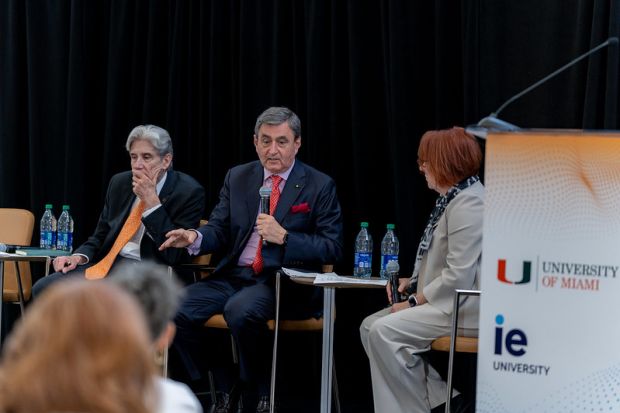Proclaiming “university lectures don’t work” lost its shock value about a decade ago, with the once-heretical idea now regarded as a truism. So why do lectures remain the dominant teaching model in most universities?
A lack of evidence that learning from lectures is almost non-existent is certainly not the reason, insists the “father of the flipped classroom” Eric Mazur, the Balkanski professor of physics and applied physics at Harvard University, who says he can point to numerous studies on the matter, including his own. Instead, the absence of incentives and rewards for moving away from the “sage on the stage” approach explains higher education’s inertia, he said.
“The lecture gives the perfect illusion of learning for both students and lecturers, but it just doesn’t intellectually engage students in a meaningful way,” said Professor Mazur, whose influential 1997 book Peer Instruction popularised the shift away from lecture-based learning to more student-engaged teaching.
“But it’s difficult to give up lecturing if you think you’re good at it. My students used to tell me I was a brilliant lecturer but when I tested them on what they actually retained, it was pretty shocking,” continued Professor Mazur, who was speaking to Times Higher Education at the Reinventing Higher Education summit held by Spain’s IE University in Miami last month.
Campus resource collection: How to be an engaging teacher
With academics under pressure to win research grants, publish papers and mentor PhD students, revamping their teaching is low on their priorities, particularly if students seem happy enough with a standard 45-minute talk, explained Professor Mazur. “It’s not something you can do overnight – it’s hard work and can take weeks. Even I wouldn’t be willing to give up a research sabbatical to overhaul my teaching,” he added.
To this end, Professor Mazur founded Harvard’s Link project, which provides teaching cover for lecturers while they tear up their yellowing lecture notes and plan more imaginative and engaging lessons. “If you’re changing two semesters of teaching, you’ll get two semesters of replacement teaching,” he said of the programme, which has provided 29 teaching fellowships in the past four years.
The scheme encourages Harvard educators to “refresh their mindset” regarding teaching as they redesign their courses, said Professor Mazur. “Most will try to leave their service work behind and visit a number of institutions for ideas,” he said, adding “it shouldn’t be a luxury to have time to educate yourself about teaching.”
It is open to all types of Harvard academics regardless of subject, seniority or even time served, said Professor Mazur. “We’ve had fairly new assistant professors who do not have tenure who have successfully applied. A junior faculty member applied before she’d even started teaching her first course, which we felt was premature but we liked her attitude and created an associate fellow post so she could come to our fellows events,” he said.
“Our hidden agenda is to create a culture shift towards teaching innovation, which is very difficult in a very established institution with hundreds of years of tradition,” said Professor Mazur, who strives to revamp his own teaching methods regularly. These days his students are found working together in groups dotted around Harvard’s campus – a set-up that requires him to travel to them if explanations are required, he said.
“I don’t think the lecture is entirely useless – it can sometimes inspire and stimulate, but it doesn’t really educate. If you use it for the primary form of teaching then you’re not providing effective learning,” said Professor Mazur, who argued that the growing reports of empty or half-empty lecture halls since the pandemic underlined the urgent need to transform teaching.
“It’s telling us that students do not perceive the lecture as adding value to their learning experience. That’s equally true for lectures available on catch-up which is why students are watching them at one-and-a-half or double speed,” he said.
The roots of the large teaching lecture go back almost 1,000 years to the world’s first university in Bologna, Italy, when society lacked the technology to pass on knowledge in written form, reflected Professor Mazur.
“In a sense, the lecture has been out of date since Gutenberg’s printing press arrived on the scene, yet we’ve continued to use it at research universities for the past 150 years nonetheless. It’s an art form that some lecturers enjoy but we should really stop pretending that we’re teaching in the Middle Ages – we need to offer an experience to students that really captures their imagination,” he said.




